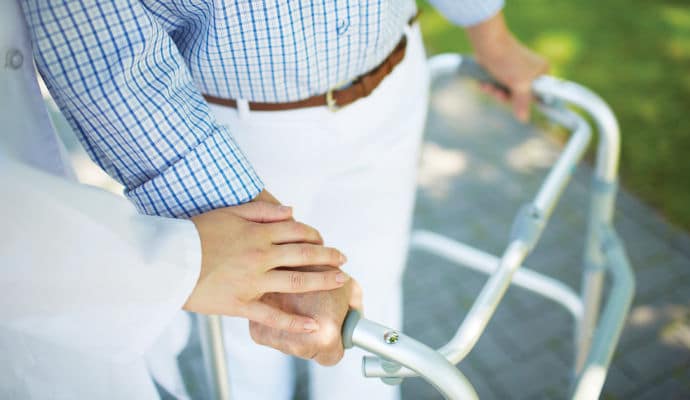
Caring for someone with Parkinson’s disease means adapting to a new way of life, learning how to manage symptoms, and helping them stay as independent as possible. Vive Health explains what Parkinson’s is and how symptoms affect daily life. They also share helpful tips on preventing falls, increasing independence, managing freezing episodes, and managing Parkinson’s medications.
What is Parkinson’s disease?
Parkinson’s is a degenerative disease which affects the brain and central nervous system. It mostly affects the part of the brain that controls body movement.
Parkinson’s damages the brain cells that are responsible for producing the neurotransmitter dopamine. Without dopamine, which carries important messages to other parts of the brain and body, brain cells can’t function properly and may even die off.
This causes a loss in motor capabilities (body movement) as well as a decline in automatic functions like blinking, smiling, or swinging your arms when you walk.
How Parkinson’s symptoms affect daily life
Symptoms of Parkinson’s primarily affect how the body moves, which significantly changes daily life for both you and your older adult.
Symptoms may include:
- Tremors – a main symptom of Parkinson’s. It often begins in the hands, arms, and legs, often happening when the body is not moving and going away when movement starts.
- Slowed movements (bradykinesia) – a key marker of Parkinson’s, it may look like dragging feet on the floor or taking an extremely long time to complete basic tasks.
- Contracture – a growing rigidity of muscles and joints that limit range of motion and flexibility. It can even lead to skeletal deformities.
- Balance problems – weakness, muscle rigidity, and slowed movements all contribute to balance problems and increased risk of falling.
- Speech changes – decrease in voice volume as well as slurred or slowed speech accompanies progression of Parkinson’s
Additional non-motor symptoms can also impact daily life. These include excessive sweating, loss of smell, mood/personality changes, constipation, urinary urgency, difficulty writing, trouble sleeping, hallucinations, and even neck pain.
Fall prevention
A main responsibility when caring for someone with Parkinson’s is preventing and managing falls. Because of all the movement-related symptoms, fall risk increases significantly and can lead to serious injury and increased risk of death.
Fall prevention includes improving home safety with grab bars, handrails, and overhead lighting as well as clearing away clutter and installing alarm equipment like fall mats or medical alert systems.
Caregivers also need to learn proper technique for helping someone off the floor in the event of a fall. The Parkinson’s Foundation shares helpful tips in their handy guide:
- Make sure they’re not injured
- Give them time to rest before moving
- Help them scoot to a large piece of furniture they can use for support
- Use a transfer belt or other transfer/lifting device to assist you
- Try not to panic and help your loved one relax to avoid stress-induced anxiety or freezing episodes
Maintaining independence in daily tasks
In addition to impaired mobility, Parkinson’s can make seemingly simple tasks like brushing teeth and eating very difficult. But staying as independent as possible is important for your older adult’s self-esteem and well-being.
Assistive devices like dressing aids, shower chairs, and reacher grabbers can allow older adults to accomplish more tasks on their own. Plus, there are products that are designed specifically for Parkinson’s that counteract symptoms like tremors and contracture. For example, spoons for people with Parkinson’s are specially designed to make feeding oneself easier and less messy.
Managing Parkinson’s freezing episodes
As Parkinson’s worsens over time, “freezing episodes” may happen. This is where your older adult will literally stop everything they are doing (“freeze”) and be unable to move.
For example, they could be walking through a room, getting to a doorway, and then not be able to move forward through it. Freezing episodes are confusing and dangerous because they can lead to falls.
These tips and tricks help manage freezing episodes:
- Asking your older adult to shift weight from one leg to the other
- Putting on music, singing, or counting to help your loved one keep moving
- Placing tape on the floor at doorways your loved one commonly uses (a line made with tape, drawn with pencil, etc. can help the brain cue the legs to walk “over” something when they freeze
- Encouraging them to try a different type movement to get the body started, like raising a hand or turning their head
Managing Parkinson’s medication
Medication management is another important part of caring for someone with Parkinson’s. Many medications have incredibly specific guidelines for where and when they should be taken.
For example, some pills must be taken only a certain amount of time after eating. Or, a patch must be applied to a specific part of the body that changes daily.
Being vigilant about managing these medications with reminders, charts, and organizers helps manage Parkinson’s symptoms.
Recommended for you:
- How Parkinson’s Disease and Dementia Are Related
- 7 Meaningful Ways to Support Seniors with Chronic Illness
- Could Your Senior’s Medications Cause Symptoms of Parkinson’s Disease?
Guest contributor: Jessica Hegg is the content manager at ViveHealth.com. Interested in all things related to living healthy lifestyle, she works to share valuable information aimed at overcoming obstacles and improving the quality of life for others.
Image: House Calls Home Health
This article wasn’t sponsored and doesn’t contain affiliate links. For more information, see How We Make Money.




